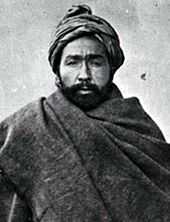Habibullāh Kalakāni
| Habibullah Kalakani | |||||
|---|---|---|---|---|---|
| King of Afghanistan | |||||
 | |||||
| Reign | 17 January 1929 – 16 October 1929 | ||||
| Coronation | 17 January 1929 | ||||
| Predecessor | Inayatullah Khan | ||||
| Successor | Mohammed Nadir Shah | ||||
| |||||
| Born |
19 January 1891 Kalakan, Kabul Province | ||||
| Died |
1 November 1929 (aged 39) Kabul, Kabul Province | ||||
| Religion | Islam | ||||
 | ||||||||||||||||||||||||||||||||||||||||||
| History of Afghanistan | ||||||||||||||||||||||||||||||||||||||||||
|---|---|---|---|---|---|---|---|---|---|---|---|---|---|---|---|---|---|---|---|---|---|---|---|---|---|---|---|---|---|---|---|---|---|---|---|---|---|---|---|---|---|---|
| Timeline | ||||||||||||||||||||||||||||||||||||||||||
|
Ancient
|
||||||||||||||||||||||||||||||||||||||||||
|
Medieval
|
||||||||||||||||||||||||||||||||||||||||||
|
Modern
|
||||||||||||||||||||||||||||||||||||||||||
| ||||||||||||||||||||||||||||||||||||||||||
Habibullah Kalakani, also known as Bach-e-Saqaow, (19 January 1891 – 1 November 1929), (Persian: حبیبالله کلکانی), was Emir of Afghanistan from January to October 1929 after deposing Amanullah Khan with the help of various Afghan tribes who opposed modernization of Afghanistan.[1] After gaining power in Kabul, he named himself Habībullāh Khādem-e Dīn-e Rasūlallāh ("The servant of the religion of the messenger of God"). He was himself defeated and overthrown nine months later by Mohammed Nadir Khan.[2][3]
Early years
Kalakani was born in 1891 in the village of Kalakan, north of Kabul. An ethnic Tajik, his father Aminullah delivered water to people's houses, and Kalakani became known as "Bache Saqqaw" (Son of a Water Carrier).[2][4] It is believed that he met an old Sufi man who told him that he would one day become an amir and then handed him an amulet to keep for good luck.[5]
During his adolescence, Kalakani ventured out of his village and travelled to the city of Kabul where he joined the Afghan National Army. It is reported that he deserted the army with his rifle and fled to Peshawar in neighbouring British India (now Pakistan).[2] He performed odd jobs there, including selling tea on the streets. He also spent 11 months in prison at Parachinar after breaking into a house. By 1924 Kalakani became a highway robber and a member of a rebel group in his village. To his Kohistani Tajik followers he became some what of a Robin Hood figure, stealing mostly from wealthy highway travellers. "To his opponents, he was regarded as a bandit and a common criminal."[4]
Revolt
King Amanullah had returned from Europe in 1928 and brought with him many Western ideas, including social and cultural changes. His aim was to rapidly modernize the country. These ideas upset the ultra-conservative Shinwari tribe of eastern Afghanistan, who began calling for the banishment of Amanullah from Afghanistan. With support from fellow Tajik forces Kalakani took advantage of the tribal revolt by the Shinwaris and others.
While the Afghan National Army was engulfed in severe battle in Laghman and Nangarhar, Kalakani and his Tajik forces began to attack Kabul from the north. The revolt caught steam and right away the country was in civil war. Tribes from Waziristan had the southern areas of Kabul surrounded, and Kalakani's rebels were moving into the heart of Kabul from the north. At first he was repelled but after taking refuge in Paghman for several days he and his forces managed to take over Kabul.[4]
In the middle of the night, on 14 January 1929, Amanullah Khan handed over his kingdom to his brother Inayatullah Khan and escaped from Kabul towards Kandahar in the south. Two days later, on 16 January 1929, Kalakani wrote a letter to King Inayatullah Khan to either surrender or prepare to fight. Inayatullah Khan's response was that he had never sought nor wished to be king and agreed to abdicate and proclaim Kalakani as the King on 17 January.
Kingship and overthrow
After he took over of the Arg (Presidential Palace) in Kabul, he discovered 750,000 British pounds and began to use that to pay the salaries of his soldiers.[2] Kalakani's first order was to remove all the flowers from the presidential grounds and plant vegetables instead. He closed schools for women and all western education centres.
By September 1929, Amanullah Khan attempted to organize a new army and recalled his top general, Nadir Khan, from Europe. General Nadir Khan's army quickly passed through the west and southern Afghanistan. They had better weapons and the support of the people as many volunteers joined the army.
Nadir Khan was furnished with thousands of troops from various parts of Pashtunistan, including southern Afghanistan. The troops fast approached Kabul and began defeating the forces of Kalakani. By late October 1929, Kabul was surrounded by Nadir Khan's army. It included Shah Wali Khan, brother of Nadir Khan and brother-in-law of Amanullah. The two brothers recaptured the Arg and arrested Kalakani along with his followers.[2]
Death

Kalakani was executed by firing squad on 1 November 1929 along with his brother and ten other rebel leaders. The bodies were subsequently put on display, while already stiff, as is shown by the awkwardness of their positions.[2] His place of burial is unconfirmed but it is probably his home village, Kalakan.
References
- ↑ "Habibullah Kalakani". Afghanistan Online. Retrieved 3 September 2006.
- ↑ 2.0 2.1 2.2 2.3 2.4 2.5 Adamec, Ludwig W. (2011). Historical Dictionary of Afghanistan. Scarecrow Press. p. 183. ISBN 0-8108-7957-3. Retrieved 2012-08-28.
- ↑ Dupree, Louis: "Afghanistan", page 459. Princeton University Press, 1973
- ↑ 4.0 4.1 4.2 Clements, Frank (2003). Conflict in Afghanistan: A Historical Encyclopedia. ABC-CLIO. p. 377. ISBN 1-8510-9402-4. Retrieved 2012-08-28.
- ↑ "Habibullah Kalakani". Afghanland.com. Retrieved 3 September 2006.
External links
| Wikimedia Commons has media related to Habibullah Kalakani. |
| Regnal titles | ||
|---|---|---|
| Preceded by Inayatullah Khan |
King of Afghanistan 17 January 1929 – 16 October 1929 |
Succeeded by Mohammed Nadir Shah |
| ||||||||||||||||||